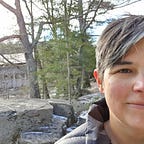50in50by50 State #12: Connecticut
Connecticut — 57.66Km
Updated June 2022
- April 15, 2022: 7.74Km up to Heublein Tower via the Metacomet trail then back via the fire road/ridge view (photos)
- April 16, 2022: 14.16Km from 3 walks: around Nepaug Dam (photos), a quick hike into Jones Mountain Preserve (photos), and a few miles on the Farmington River Trail (photos)
- April 17, 2022: 10.32Km in Penwood State Park (photos) and 6.05Km around Hartford Reservoir #6 (photos)
- April 29, 2022: 14.51Km on the Farmington Canal Greenway in New Haven (photos)
- June 9 & 10, 2022: 4.88Km bonus day in Waterbury (photos)
The April 15 trip was planned out to have a short hike Friday on arrival, a long day on Saturday combining paved trails and off-road hiking, and pick up any remaining distance on Sunday, off-road. But as I finished up the walk on Friday, I took a bad fall on a busy road and wrecked both knees, so plans changed. I’m not glad that I’m still a little sore two weeks later from the fall, but I am glad that I had an excuse to go to New Haven.
Where to get some distance in Connecticut
- You’d really be missing out in Connecticut if you don’t try part of the Metacomet trail, which is a part of the 215-mile New England Trail (NET). On our first trip, we stayed near Simsbury in a cluster of towns that are maybe best described as “horse country” and are very friendly toward hikers, cyclists and the outdoors in general. Bathrooms in Talcot Mountain Park at the tower and main parking area and also in both parking lots at Penwood. Terrain (for the Metacomet in Talcot Mountain and Penwood State Parks): off-road with some challenging passages, particularly in mud season, with areas of climb and descent. You can opt for easier footing and somewhat more gradual ascent/descent in both of these parks on crushed gravel roads, and Penwood has a paved road loop as well.
- There are all sorts of East Coast Greenway trails in CT that are well maintained. The portion I walked in New Haven showed me a side of the city that I personally love, but you may not, so buyer beware. Once you leave Yale’s campus, you’re moving largely between light industrial and residential areas in Newhallville and then behind big box stores as you move north. It isn’t scenic in the classic sense, and depending on when you go it can be very sparsely populated (like, post-zombie-apocalypse sparse) but it shows you so much more than staying confined to Yale’s citywide campus. Visitors to any city typically don’t have any cause to walk through its light industrial areas. I deeply appreciate New Haven for sharing that part of itself with walkers and cyclists. There are no bathrooms to speak beyond coffee shops in the city and big-box stores at about the 3 mile mark. Terrain: paved and well maintained with almost no elevation changes.
Celebrating Connecticut’s Indigenous Voices
Non-native perceptions of modern Indigenous people tend toward myths and misconceptions, and many of the most harmful myths center around money, including casino money.
Connecticut’s Mashantucket Pequot and Mohegan are among the very few nations to have large casino enterprises operate on their land. Casino money is complex and there are a lot of myths, but basically: no, the vast majority of Indigenous people do not get checks from casino profits, though some may of course be employed by their nation’s gaming operations.
Nations that operate casinos, like all other large businesses, have debts and operating costs to pay. But unlike large businesses, these nations also have governments to run, and public services to provide. Just as the lottery helps support public schools in some states, tribal gaming can help support the public services on tribal land. So yes, casino profits may provide a benefit to society, but that does not necessarily come in the form of cash. And of course, like the lottery, casinos bring their share of harms as well.
Nations are not fully independent in their use of gaming profits, and the ways in which profits are used are under the direction of the National Indian Gaming Commission, which is a federal agency. Only federally recognized tribes can operate a casino on their land.
This makes the stakes really high for nations like the Schaghticoke who are fighting for federal recognition but whose neighbors fear another Mohegan Sun on their doorstep. Yet federal recognition is about so much more than the ability to operate a casino — it’s about enduring land trust for a nation’s descendants and it’s about an acknowledgement of the nation’s sovereignty. In many ways it is an official recognition, hundreds of years overdue, of an entire nation’s right to exist.
Five nations are recognized by the state of Connecticut, two of which — the Mashantucket Pequot and Mohegan — are also federally recognized. They are the Golden Hill Paugussett, Mashantucket Pequot, Mohegan, Paucatuck Eastern Pequot, and Schaghticoke. As of the 2020 census, 1.7% of Connecticut’s population identified as American Indian in whole or in part.
I have set myself a goal of completing at least 50Km in all 50 states by the time I’m 50. To acknowledge that I’m traveling on land that was stolen from others, I am donating $500 to the First Nations Development Institute for each state I complete.
Thank you for reading and supporting me on this journey. If you’re able to chip in — for your state, or for all 50 states — you’ll help me double the impact I’m able to make on my own.
If you’re from Connecticut or living there right now, please consider supporting the Mashantucket Pequot Museum, or donating to another local and indigenous-led organization.
